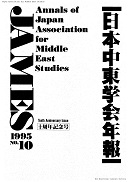Volume 10
Displaying 1-14 of 14 articles from this issue
- |<
- <
- 1
- >
- >|
-
Article type: Article
1995Volume 10 Pages 1-25
Published: March 31, 1995
Released on J-STAGE: March 30, 2018
Download PDF (1720K) -
Article type: Article
1995Volume 10 Pages 27-67
Published: March 31, 1995
Released on J-STAGE: March 30, 2018
Download PDF (2545K) -
Article type: Article
1995Volume 10 Pages 69-90
Published: March 31, 1995
Released on J-STAGE: March 30, 2018
Download PDF (1518K) -
Article type: Article
1995Volume 10 Pages 91-116
Published: March 31, 1995
Released on J-STAGE: March 30, 2018
Download PDF (1516K) -
Article type: Article
1995Volume 10 Pages 117-134
Published: March 31, 1995
Released on J-STAGE: March 30, 2018
Download PDF (1346K) -
Article type: Article
1995Volume 10 Pages 135-156
Published: March 31, 1995
Released on J-STAGE: March 30, 2018
Download PDF (1614K) -
Article type: Article
1995Volume 10 Pages 157-177
Published: March 31, 1995
Released on J-STAGE: March 30, 2018
Download PDF (1537K) -
Article type: Article
1995Volume 10 Pages 179-198
Published: March 31, 1995
Released on J-STAGE: March 30, 2018
Download PDF (1305K) -
Article type: Article
1995Volume 10 Pages 199-213
Published: March 31, 1995
Released on J-STAGE: March 30, 2018
Download PDF (892K) -
Article type: Book Review
1995Volume 10 Pages 215-221
Published: March 31, 1995
Released on J-STAGE: March 30, 2018
Download PDF (576K) -
Article type: Book Review
1995Volume 10 Pages 223-230
Published: March 31, 1995
Released on J-STAGE: March 30, 2018
Download PDF (485K) -
Article type: Article
1995Volume 10 Pages 245-263
Published: March 31, 1995
Released on J-STAGE: March 30, 2018
Download PDF (1165K) -
Article type: Index
1995Volume 10 Pages 265-292
Published: March 31, 1995
Released on J-STAGE: March 30, 2018
Download PDF (828K) -
Article type: Index
1995Volume 10 Pages 293-298
Published: March 31, 1995
Released on J-STAGE: March 30, 2018
Download PDF (227K)
- |<
- <
- 1
- >
- >|
